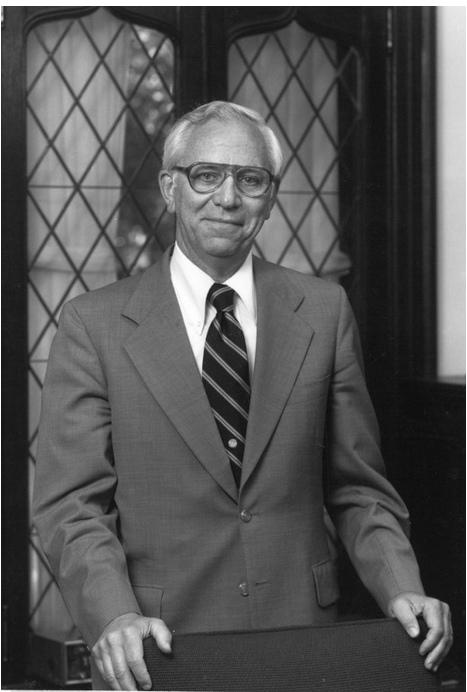
Wilkes University Archives has a guest blog post today written by Archives Intern, Jennifer Boch, a Wilkes University sophomore majoring in Public History and International Relations. Jennifer has previous experience in archival work from an internship at the University of Pennsylvania Museum of Archaeology and Anthropology. In the Fall 2019 Jennifer processed The Robert S. Capin Papers, 1960-1987 and has some reflections that she’d like to share. The blog post and finding aid were edited and supervised by Suzanna Calev, Wilkes University Archivist.
President Patrick Leahy stated after the passing of Dr. Robert Capin in 2015, “His [Capin’s] presidency was marked by financial stability and growth that provided a strong foundation for the university we know today. We who serve Wilkes are indebted to him for his legacy.” Robert Capin was born in 1926 and served in the U.S Navy at age 18 during WWII. Dr. Capin attended Wilkes College, receiving his degree in 1950. Five years later, he returned as a part time professor of accounting. Dr. Capin became involved with the administration in 1965, and climbed the ranks until becoming president after Dr. Michelini’s departure. He served as the third President of Wilkes University from 1974 through 1984. Dr. Capin was very involved in the greater Wilkes-Barre area and served on the board of many organizations. After his retirement, he taught classes right down the street at the Jewish Community Center until his passing in 2015.
One of the most fascinating things I discovered while looking through the Capin papers is the story of Mykolas Zilinskas (1904-1992) and his art collection. Organized in “Art – Collection 1967 – 83,” this file reveals that Wilkes University was close to obtaining a massive impressive art collection, but was unable to close the deal due to greater political reasons.


Zilinskas was living in West Berlin when he contacted Dr. Farley in 1967 concerning an extensive art collection of 500-600 paintings he gathered over a 30 year period. Many of these paintings had been authenticated and included famous artists such as Monet, Van Gogh, Degas, and Rembrandt. Dr. Farley visited him and then welcomed him on campus the following year.

However, Zilinskas had an outdated Lithuanian passport and was facing allegations of illegal dealings while in Berlin during Hitler’s rule. Therefore, the US State Department denied his visa and would not reconsider, causing the art collection to slip through the fingers of Wilkes College. The correspondence between the college and him stops. Upon further research, I learned that Zilinskas found another home for his art collection in Kaunas, Lithuania. Today, it is housed under the MK Čiurlionis National Museum of Art as the M. Zilinskas art gallery.

I personally also found Dr. Capin’s speeches (within Series 1: Administration) very intriguing. He has some rather quotable moments and the folders contain some of the rough drafts and revisions of his speeches, a process that students who have taken COM 101 understand too well. Dr. Capin also had some unusual correspondence. He sent letters from the British House of Commons, concerning the 50th anniversary of the college and its namesake John Wilkes. He sent recommendations and endorsements to the Nobel Committee in Oslo, Norway. Dr. Capin even tried to get Pope John Paul II to visit Wilkes-Barre when he came to the US!




In addition to potential art collections and speeches, this collection could be used as primary sources to understand how aspects of higher education have changed over time. For example, the Reaction Survey (Box 1.6) drew specific attention as it was filled out by graduating students in 1983. Questions dealt with academic and social life at Wilkes College, such as how they felt about their classes and living in the residence halls. Their answers sound like they were filled out by Wilkes Students today.

Tenure – Ad Hoc Tenure Policy Study Committee, 1977-78
If you’re interested in examining how “college student culture” has changed over time and what has stayed consistent, this collection would be a great primary source. Faculty policies, such as tenure procedure, that are found in this collection could also be used to understand how faculty practice procedures and policies have changed through the decades. There are also several articles and discussions within this collection debating on the validity of tenure, which could be useful to specific research and understanding.

From Tenure – Ad Hoc Tenure Policy Study Committee, 1977-78

Tenure – Ad Hoc Tenure Policy Study Committee, 1977-78
Overall this collection shows how active and expansive Capin’s presidency was. He was involved at the university as a student, faculty member, and then administration for over a period of more than 40 years. This gave him a perspective that other presidents might not have understood. He wanted to grow his alma mater into something bigger and better, and I think he did during his time. As a resource available for study and research, I would highly recommend considering exploring these materials and go back to the 1970s-1980s for a quick visit with Dr. Capin and Wilkes College.
